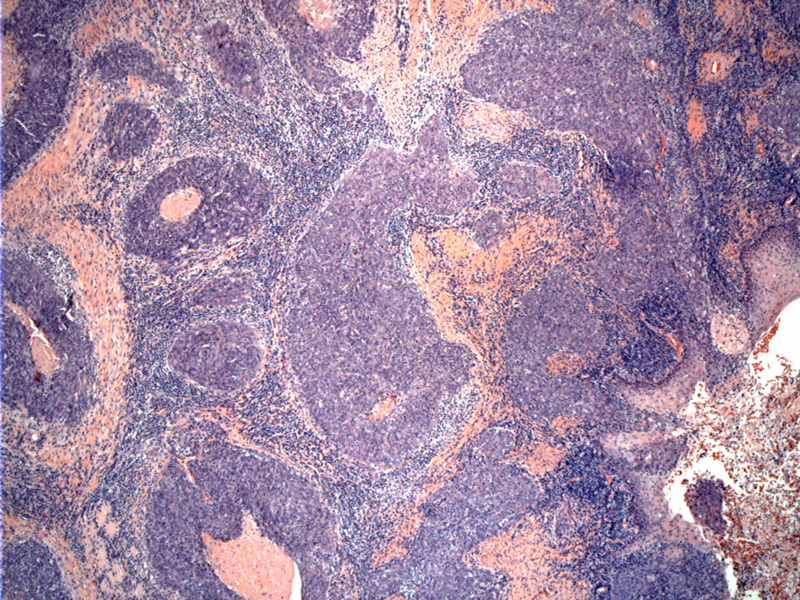

The primary tumor often arises in the tonsils and does not show surface dysplasia. TUmors often grown in a vaguely lobulated fashion.
Basaloid growth characerized by crowded hyperchromatic cells with scant cytoplasm is highly characteristic. However, not all basaloid tumors are HPV positive.
A corresponding positive node shows uniformly strong p16 staining. The immunostaining staining status for p16 strongly correlates with HPV status.
p16 is present in the surface of the tumor.
Many penetrating lymphocytes within the tumor is a characteristic feature of p16+ oropharygeal cancers.
The corresponding p16 stains the malignant population and spares the benign squamous epithelium.
Tumors are often keratinizing but limited in its extent.
In the US, about 40-80% of oropharyngeal cancers are associated with HPV 16. HPV-driven head and neck squamous cell carcinomas arise most often in the linguil and palatine tonsils as in this case.
HPV has a predilection for the highly specialized reticulated epithelium that lines the tonisllar crypts. The virus requires basal epithelial cells capable of proliferation, gaining access to the basal layer of stratified squamous epithelium through structural breaks in the stratified
epithelial superstructure. Overall, about 25% of all head and neck squamous cell carcinomas contain detectible HPV DNA (Allen).
Patients are often younger and lack the extensive smoking and/or alcohol abuse history .
Treatment for locally advances (T3-4 or N2-3) oropharygeal cancer involves surgery and adjuvant radiation with or without concurrent cisplatin, or more usually, concurrent chemoradiation for preservation of speech and swallowing function.
Patients have a significant improvement in survival when treated with adjuvant therapy. These tumors often present in early T stage but node positive stage, yielding many patients with clinical stage III or IV. Overall, HPV+ ENT tumors do better than HPV- ones. When restricted to oropharyngeal cases, overall survival at 2 years has been shown to be as high as 94% for HPV+ cases, compared to 58% for HPV- (Fakhry).
These tumors represent a unique subset oropharyngeal squamous cell carcinoma with the lack of tobacco/EtOH association, increased responsivenss to therapy, and improved prognosis
• Larynx : Squamous Cell Carcinoma
• Oral Cavity : Basaloid Squamous Cell Carcinoma (Tongue)
Fakhry C, et al. Improved survival of patients with human papillomavirus-positive head and neck squamous cell carcinoma in a prospective clinical trial. J Natl Cancer Inst 100. 261-269, 2008.
Allen CT,et al. Human papillomavirus and oropharynx cancer: biology, detection and clinical implications. Laryngoscope. 2010 Sep;120(9):1756-72.